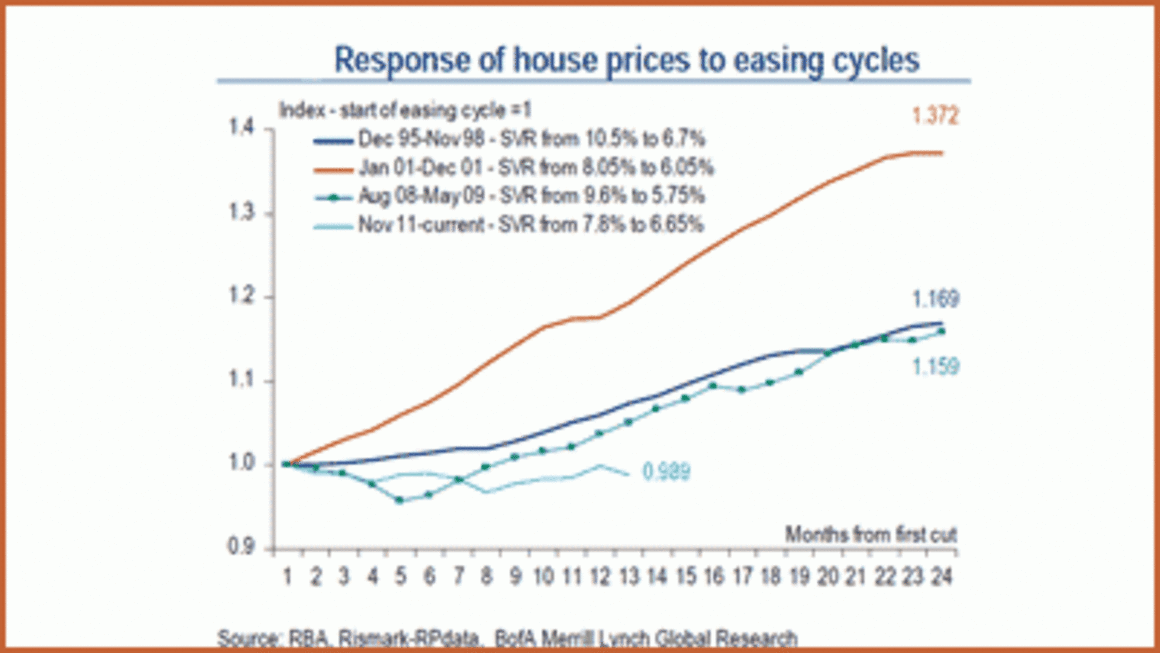RBA rate cuts stimulating 'relatively moderate' housing market recovery: Bank of America Merrill Lynch

The Reserve Bank is falsely pinning its hopes that lower interest rates will stimulate a recovery in housing construction, according to Bank of America Merrill Lynch Australia economists Saul Eslake and Alex Joiner.
They point to the muted impact that six rate cuts since November last year have had to date on both house prices and building approval figures – the weakest response to monetary policy stimulus in a decade – and anticipate only a "relatively moderate" recovery in residential construction" compared with previous cycles.
The RBA is hoping that when the mining and liquid natural gas (LNG) investment boom tails off in the next few years, the slack will be taken up by a boom in housing construction and a broader recovery in the housing market.
Last week, Jonathan Kearns,head of economic analysis at the RBA, said in a speech on the outlook for dwelling investment that there were “tentative signs” that investment in housing “will pick up which would, in part, offset the smaller contribution to growth that we expect from resource investment in the coming years”.
But in a research report, Eslake and Joiner say that despite the RBA being over a year into the current monetary policy easing cycle, "the response from both house prices and residential construction has so far been measured at best".
Click to enlarge"We argue that due to structural and cyclical factors that any upswing in dwelling prices and investment over the coming year will remain relatively modest compared with previous cycles," they say.
The cash rate has fallen 150 basis points between November 2011 and October 2012, and banks’ standard variable mortgage rates have dropped 120 basis points in response, but Eslake and Joiner calculate that median house prices are still 1.2% lower than they were in October 2011 and have climbed just 2% since bottoming out in May.
In comparison, house prices increased by nearly 37% after the Reserve Bank cut interest rates by 200 basis points (from a cash rate of 6.25% to 4.25%) between January 2001 and December that year, and by a further 16% after the GFC, when the RBA cut the cash rate by 425 basis points from September 2008 to April 2009 (7.25% to 3%).
Building approval figures for detached houses – a forward indicator of future construction activity – have also not responded to the current rate-cutting cycle and are down 1.8% for the year to September in comparison with the units and apartment approval, which are up 41.6% year-on-year.
"This underperformance of detached housing approvals in particular is likely to result in the overall recovery in approvals and subsequently residential construction in the coming year being significantly less pronounced than in previous cycles," say Eslake and Joiner.
"This is especially true when we note that at least part of the strength in ‘other’ approvals was prompted by regulatory changes and alterations to state governments’ first home buyer grants (which will nonetheless boost dwelling investment growth in the short term).
"Our rationale for this is that despite easier monetary policy and Commonwealth and state government initiatives designed to boost the supply of housing (first home buyer grants, negative gearing etc) several factors are conspiring against any significant and sustained addition to housing supply."
These include macroeconomic headwinds (slowing activity and higher unemployment), regulatory processes becoming "ever more burdensome, drawn out and costly", high infrastructure and developer costs and softer sale prices.
Other reasons noted by Eslake and Joiner include a winding back of some government housing grants and slower income growth as seen in last week quarterly wage price index which eased back to 0.7% quarter-on-quarter growth below 0.9% to 1% growth in the last three quarters.
They also note that housing finance approval levels are "gradually rising spurred by lower mortgage interest rates and improved sentiment towards the housing market" which should continue in coming months.
"However, with approvals levels only 10% higher than lows experienced in early 2011 the recovery been less than convincing thus far (levels remain 10% below average levels since 2000)."
"With uncertainty in the labour market high, household caution will likely keep the recovery in approvals levels more modest than we have seen in previous monetary policy easing cycles. This will cap any recovery in housing credit growth going forward from what is currently historically low on an annual basis."
“With the debt to income ratio now having ‘plateaued’ at around 150%, households have seemingly recognised a limit to their borrowing capacity.
“As such, a more modest expansion of incomes will result not only in lower house price growth but also significantly slower growth in housing credit,” they say.
Looking ahead to the December 4 RBA meeting, Eslake and Joiner say the RBA minutes from the November board meeting (out tomorrow) "are not likely to say too much that last week’s statement on monetary policy hasn’t already".
"The sentiment from the RBA is that rates are at an appropriate level for the time being.
"We are still marginally biased towards a cut in December and will assess the data flow leading into the meeting (including building approvals, retail sales and some partial third quarter GDP data) to ascertain whether there is likely a need for a further easing of policy in the short term."
